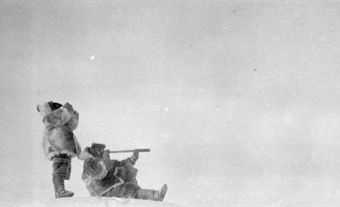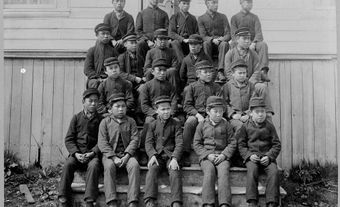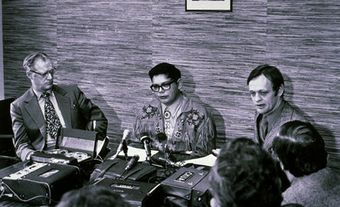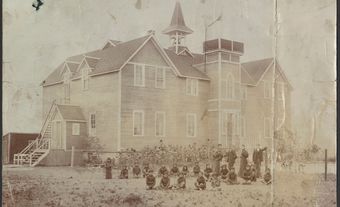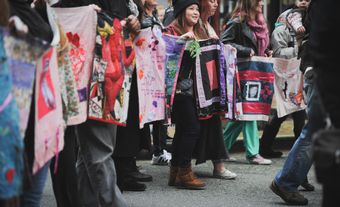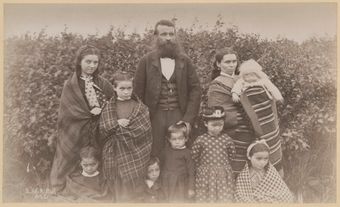The Truth and Reconciliation Commission of Canada (TRC) was officially launched in 2008 as part of the Indian Residential Schools Settlement Agreement (IRSSA). Intended to be a process that would guide Canadians through the difficult discovery of the facts behind the residential school system, the TRC was also meant to lay the foundation for lasting reconciliation across Canada.
This is the full-length entry about the Truth and Reconciliation Commission. For a plain language summary, please see Truth and Reconciliation Commission (Plain Language Summary).
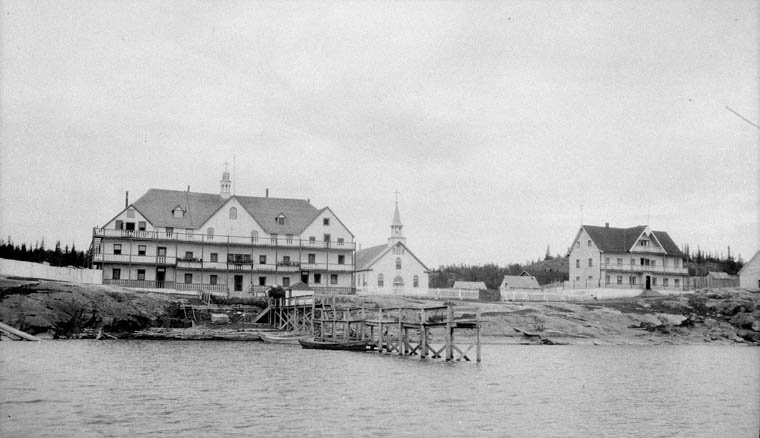
Background
The Truth and Reconciliation Commission of Canada (TRC) was created as a result of the Indian Residential Schools Settlement Agreement (IRSSA). This multi-faceted agreement, widely understood to be one of the largest settlement packages in the history of the country, was intended to compensate survivors for the harms they suffered in residential schools, and to work towards a more just and equitable future for Indigenous peoples.
Schedule N of the IRSSA was the TRC’s official operating mandate. Divided into 14 sections, the mandate outlined an ambitious set of goals, activities and requirements the commissioners of the TRC were to follow. A few specific responsibilities given to the commission include:
- Hosting seven national events
- Issuing a final report
- Establishing a National Research Centre
- Collecting all relevant documents from other church and government entities
- Overseeing and approving a $20 million commemoration fund
- Hosting community events
- Regional liaisons
- Statement gathering/truth sharing
- An active research agenda
In addition to outlining the tasks to be completed by the TRC, the IRSSA established a five-year time frame and $60 million budget for the commission to complete these tasks. As would later be seen, fulfilling this mandate would prove challenging.
Early Work and Challenges
The commission commenced with the appointment of three commissioners: Justice Harry Laforme, an Ontario Court of Appeal judge and member of the Mississaugas of New Credit First Nation; lawyer Jane Brewin Morley; and Indigenous health expert Claudette Dumont-Smith.
Despite high hopes, the Truth and Reconciliation Commission soon experienced difficulties. Less than six months after being appointed chair, Justice Harry Laforme resigned from the commission citing conflict with the commissioners, insurmountable challenges and government interference. The other commissioners followed suit some three months later. By March 2009, the TRC was seeking three new commissioners.
A New Beginning
By June 2009, three new commissioners were appointed and officially recognized in a ceremony on 1 July. These new commissioners — Justice Murray Sinclair, an Ojibwe judge from the court of the Queen’s Bench, Manitoba; lawyer Chief Wilton Littlechild from Maskwacis (Hobbema), Alberta and Marie Wilson, a well-known CBC broadcaster from Yellowknife, NT — faced the daunting task of quickly moving to re-establish the commission and to re-broker trust with Indigenous peoples following the initial failure of the TRC.
The commission relocated its head offices from Ottawa to downtown Winnipeg in an effort to maintain independence and to be closer to populations of survivors. The commission also moved quickly to hire a new executive director, followed by directors of the main functional areas of the commission’s mandate.
In an effort to draw public attention, the commission planned its first national event for June 2010 at The Forks National Historic Site in Winnipeg. This four-day outdoor event saw thousands of people listen to survivors at sharing circles, participate in a large powwow celebration and attend concert performances by well-known artists such as Buffy Sainte-Marie and Blue Rodeo.
This first event shaped proceeding national events, all of which came to share a number of core elements, including the lighting of a sacred fire, a four-day format, a call to gather each day and opportunities for survivors to share their truth with the commission in both public and private settings. The event also marked the induction of a TRC honorary witness, then-Governor General Michäelle Jean.
Next Steps – and More Challenges
Shortly after the Winnipeg national event, there was another staff turn-around. The commission’s director of research resigned, as did the executive director and National Events planning team.
Additionally, the commission began to apply pressure to government and church entities to produce their documentary records to the commission, as per the terms of the settlement agreement. While some entities complied willingly, document production would prove to be one of the most challenging elements of the commission’s mandate, seeing the Truth and Reconciliation Commission in court on five separate occasions for a variety of document collection issues.
Despite these challenges, the main activities of the commission continued to advance. The second national event was held in Inuvik, NT, in June 2011, followed by events in Halifax and Saskatoon in 2012, Montreal and Vancouver in 2013, and the final national event in Edmonton in 2014.
Throughout this time, the TRC commissioners conducted community hearings across the country, visiting over 70 communities for formal hearings and many others for community events and public outreach activities. Statement gathering programs and the TRC’s research program continued as well.
The commission also oversaw the disbursement of two funding packages, totaling $20 million, for commemoration activities across the county. These funds stimulated the creation of a range of commemorative events, which included permanent community commemoration markers, such as that created in Williams Lake, BC, in addition to some impressive works of art, such as artist Carey Newman’s Witness Blanket and the Royal Winnipeg Ballet’s Going Home Star ballet.
Creation of the National Centre for Truth and Reconciliation (NCTR)
By the summer of 2014, the commission was preparing for the end of its mandate. Granted a one-year extension, the commissioners and research staff retrenched to focus on finalizing the daunting but exhaustive work of the final report, in addition to completing the document collection mandate of the commission. With a collection now totaling close to 7,000 statements and some five million records, establishing a permanent home for these materials became pressing.
Following an extensive call for proposals and a series of formal discussions, the National Centre for Truth and Reconciliation (NCTR) was awarded to the University of Manitoba. The NCTR was recognized as the permanent home for all statements, documents and other materials collected by the Truth and Reconciliation Commission over the course of its mandate. In addition to this task, the NCTR was responsible for continuing the journey of truth and reconciliation, especially in the areas of public education, research and access to the collection.
The official closing ceremonies of the commission took place in June 2015 in Ottawa, concluding six years of work and effort by the commission.
During these ceremonies the TRC presented four summary reports, including one report dedicated solely to recounting the voices of survivors. The final complete version of the report was released on 15 December 2015, marking the final chapter in the commission’s activities and mandate.
TRC Final Report and 94 Calls to Action
The final report, Honouring the Truth, Reconciling for the Future (2015), documents the tragic experiences of approximately 150,000 Canadian residential school students. Many of these children were sexually and physically abused. The commission also found that approximately 3,200 residential school students died of malnourishment, tuberculosis and other diseases caused by poor living conditions. Justice Murray Sinclair argued that this number is likely higher, perhaps 5 to 10 times as much; however, due to poor burial records, the commission could not report a more accurate number.
The TRC labelled the residential school system as a case of “cultural genocide.” (See also Genocide and Genocide and Indigenous Peoples in Canada.) The final report defined cultural genocide as the “destruction of those structures and practices that allow the group to continue as a group.” The report concluded: “these measures were part of a coherent policy to eliminate Aboriginal people as a distinct peoples and to assimilate them into the Canadian mainstream against their will." The use of the term “cultural genocide” launched debate and discussion in Canada. While some disagreed with the use of the term, others argued it didn’t do enough to represent the suffering of Indigenous peoples in Canada.
Prime Minister Justin Trudeau attended the ceremonial report release, and has committed to implementing all of the 94 recommendations set out in the June 2015 summary. The Trudeau government began working towards one of the recommendations in December 2015 — a national inquiry into missing and murdered Indigenous women and girls. The national inquiry's Final Report was completed and presented to the public on 3 June 2019. (See also Missing and Murdered Indigenous Women and Girls in Canada.) It is estimated that some of the commission’s other recommendations, such as improving Indigenous peoples' access to post-secondary schooling, reducing the number of Indigenous children in foster care, increasing CBC/Radio-Canada funding for Indigenous programs, and addressing the health-care gap between Indigenous peoples and other Canadians, will cost the federal government tens of millions of dollars. Implementing these recommendations will also require a government fully committed to change; in the words of Justice Sinclair, “Canada must move from apology to action.”
Did You Know?
Historica Canada, using data supplied by the National Centre for Truth and Reconciliation at the University of Manitoba, has created a map (see below) of all residential schools in Canada. Part of a larger effort by Historica Canada called the Residential Schools Awareness Program, the map includes the location, name, religious denomination, opening and closing dates, and any other names by which the schools were known.
Residential Schools in Newfoundland and Labrador
The benefits of federal compensation packages excluded survivors of residential schools in Newfoundland and Labrador. Since Canada did not establish or operate residential schools in that province (Newfoundland was not part of Canada when the schools began operating), the federal government argued that it was not responsible for compensating former students. After survivors launched a class-action lawsuit against the government, a settlement of $50 million was reached on 10 May 2016. The settlement was approved by Newfoundland and Labrador Supreme Court Justice Robert Stack on 28 September 2016. More than 800 survivors in the province will now have some closure. On 24 November 2017, Prime Minister Justin Trudeau formally apologized to survivors of residential schools in Newfoundland and Labrador.

 Share on Facebook
Share on Facebook Share on X
Share on X Share by Email
Share by Email Share on Google Classroom
Share on Google Classroom


